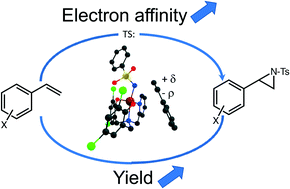Rational design of Fe catalysts for olefin aziridination through DFT-based mechanistic analysis†
Abstract
Nitrene transfer reactions are increasingly used to access various kinds of amine derivatives but the underlying mechanisms have not been unraveled in most cases. Fe-catalyzed aziridination of alkenes has appeared as a promising route to aziridines which are important derivatives both per se and as intermediates in many synthetic procedures. We report the strong activity and the mechanism of di-iron catalysts for aziridination of styrenes using phenyltosyliodinane (PhI![[double bond, length as m-dash]](https://www.rsc.org/images/entities/char_e001.gif) NTs). In addition, we have developed a similar mono-iron catalyst which operates under the same mechanism albeit with a reduced activity. DFT calculations were performed to investigate the structure and electronic structure of the FeIVNTs species of the latter catalyst. They suggest that the reaction pathway leading to the nitrene transfer to the olefin involves a transient charge transfer on the way to a radical intermediate, which is totally consistent with the experimental results. Moreover, these calculations identify the electron affinity (EA) of the active species as one key parameter allowing rationalization of the observations, which opens the way to improving the catalyst efficiency on a rational basis.
NTs). In addition, we have developed a similar mono-iron catalyst which operates under the same mechanism albeit with a reduced activity. DFT calculations were performed to investigate the structure and electronic structure of the FeIVNTs species of the latter catalyst. They suggest that the reaction pathway leading to the nitrene transfer to the olefin involves a transient charge transfer on the way to a radical intermediate, which is totally consistent with the experimental results. Moreover, these calculations identify the electron affinity (EA) of the active species as one key parameter allowing rationalization of the observations, which opens the way to improving the catalyst efficiency on a rational basis.

- This article is part of the themed collection: 2017 Catalysis Science & Technology HOT Articles


 Please wait while we load your content...
Please wait while we load your content...